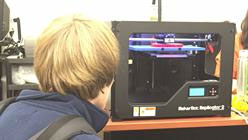Bruce Sarte
The implications of 3D printing in our society are simply mind-boggling. From NASA sending a 3D model of a wrench into space, to businesses being able to implement JOOM (Just On Order Making) and immediately produce anything your heart desires, to shipping objects via data packets that the recipient can simply print, 3D printing holds an unprecedented level of practical promise. It all sounds really great, but how does this technology impact the classroom? Immensely.
 This spring a group of independent schools in southeastern Pennsylvania had an opportunity to make a foray into the world of 3D printing. Through a program sponsored by Edu-Tech Academic Solutions, each school had use of a MakerBot Replicator 2 3D printer for several weeks to research, design, and produce a device, object, manipulative, or “thing” that supports a current area of classroom study.
This spring a group of independent schools in southeastern Pennsylvania had an opportunity to make a foray into the world of 3D printing. Through a program sponsored by Edu-Tech Academic Solutions, each school had use of a MakerBot Replicator 2 3D printer for several weeks to research, design, and produce a device, object, manipulative, or “thing” that supports a current area of classroom study.
A total of seven independent schools accepted the challenge and had to produce a two-page summary, a digital presentation of their project, and all related 3D objects. The competition would be judged based on functionality, printability, and creativity. Two of the seven schools would win a MakerBot Replicator 2 3D printer of their own.
The schools all embraced the challenge and produced some pretty significant projects utilizing TinkerCAD and the MakerBot. The students at Stratford Friends School took a historical angle, producing a model of the settlement at Jamestown. Instead of looking at pictures of the walls and structures, the students actually created them based on historically accurate information. They took that information, created 3D models, and printed something they could hold in their hands—a recreation of what Jamestown actually looked like, right in front of them! They, as a group, have taken an active role in recreating a historical scene—no traveling required.
Upland Country Day School took a slightly different slant on the challenge, asking their fourth and fifth graders to participate instead of their middle school students. They decided to replicate different working tools throughout history. For example, using historically accurate renderings of a bullet mold from the 18th century, the students printed one that could actually be used to mold a historical bullet.
I know what you’re thinking … that serves history very nicely, but what else?
- Imagine high school students being able to study an accurate 3D model of a human heart, dissected into two pieces?
- In chemistry class, students could print accurate representations of elemental molecules.
- Want something more practical? In shop class, students could print nuts and bolts that could actually be used to repair things that are broken.
- What would design students think if they could work on a design for a house—and then actually print it?
- In a cooking class, usable molds for baking could be designed and printed to bake cakes that look like just about anything you can imagine.
What is beautiful about all of these possibilities is that it is easy to create manipulatives or models that fit right into the objectives of your state standards.
For the contest, students at Delaware Valley Friends School produced a great model of our solar system. Holy Child Academy attacked the 3D printer challenge by creating three different teams, each with a different project ranging from social studies to biology. The Hill Top School accepted the challenge to produce biological models.
One of the key elements of this challenge for both the students and their advisors was the idea of designing 3D objects for printing from scratch. The students worked hard to learn the ins-and-outs of TinkerCAD, while trying to keep an eye on the scale of the objects they were printing. On more than one occasion, a project had to be redesigned or have a few key pieces reprinted because the scale of a particular piece wasn’t quite right. The students all worked hard to master the software and learn its nuances until they had a project that fit the bill.
There are so many doors that this technology opens up, and the question becomes: can a school afford it? The MakerBots being used in the challenge retail for around $1,500 each. We have designed MakerSpaces around them, complete with the computer power necessary for design, that are very affordable for schools. With the costs of the hardware coming down and the quality of the printing going up, the possibilities in the classroom are limited only by your imagination and determination.
The Edu-Tech 3D Printing Challenge is still ongoing as of the writing of this post, but take a look at the link to the challenge on Edu-Tech’s website this week to find out who won and how you can get involved!
Bruce Sarte is an educational technology consultant working with Edu-Tech Academic Solutions in Pennsylvania. He holds a degree in computer science from Temple University, and is currently pursuing his master’s in American history from American Public University. Bruce is a published author, history nut, tech geek, and food lover who lives in suburban Pennsylvania with his wife and four children. He BLOGs regularly at http://bruceasarte.blogspot.com and his website http://www.bruceasarte.com. You can also follow him on Twitter @bsarte.
Are you using or thinking about using 3D printing technology in your school or district? What are your thoughts on how this technology could revolutionize education? Please share your perspective and ideas in the Comments field below.

